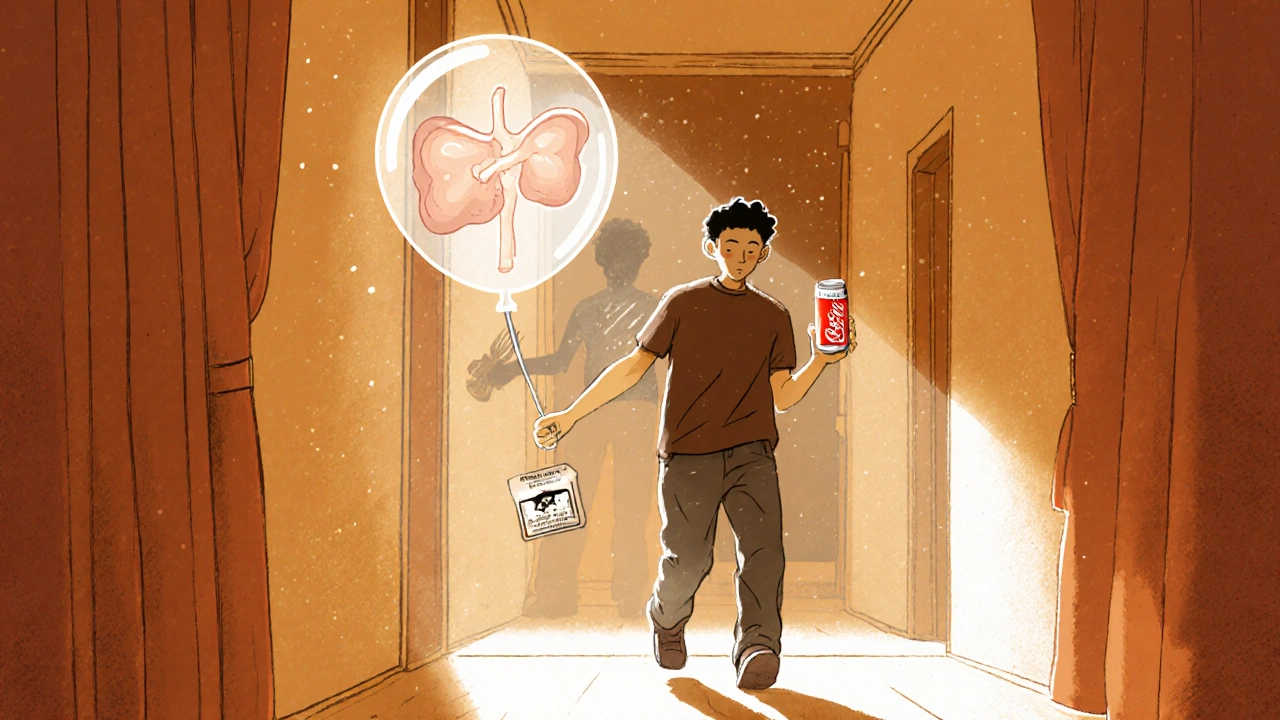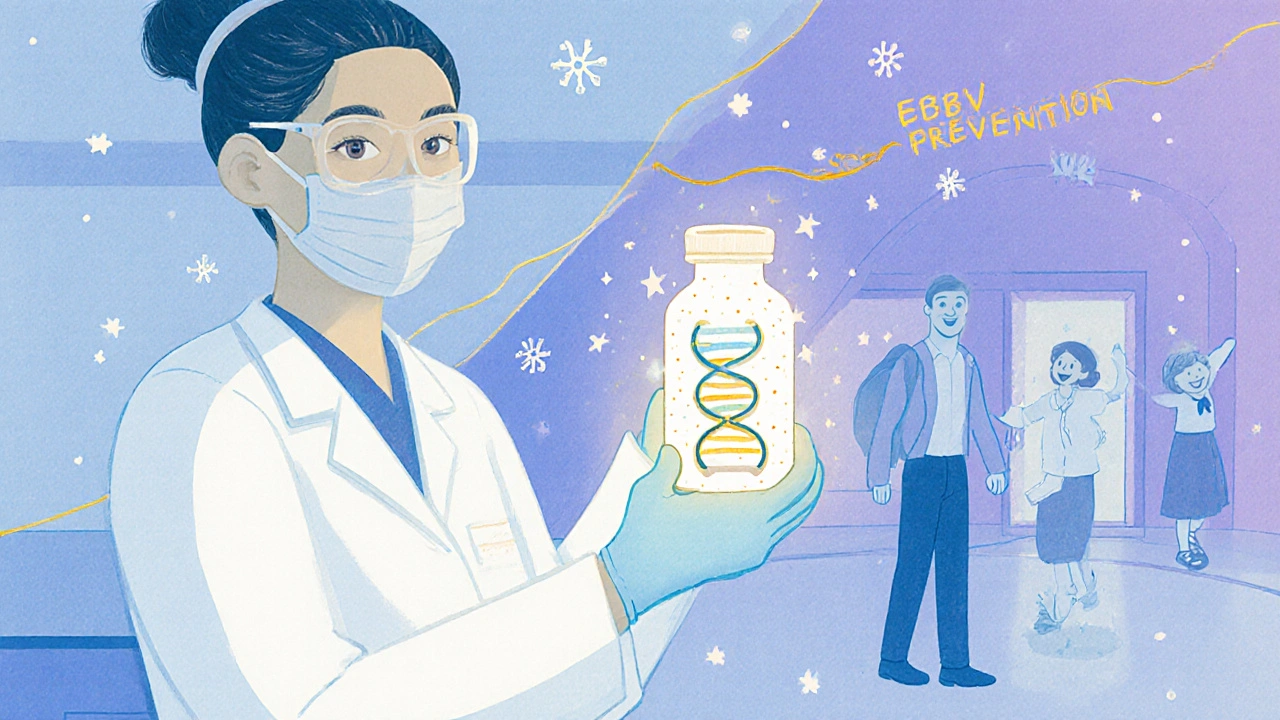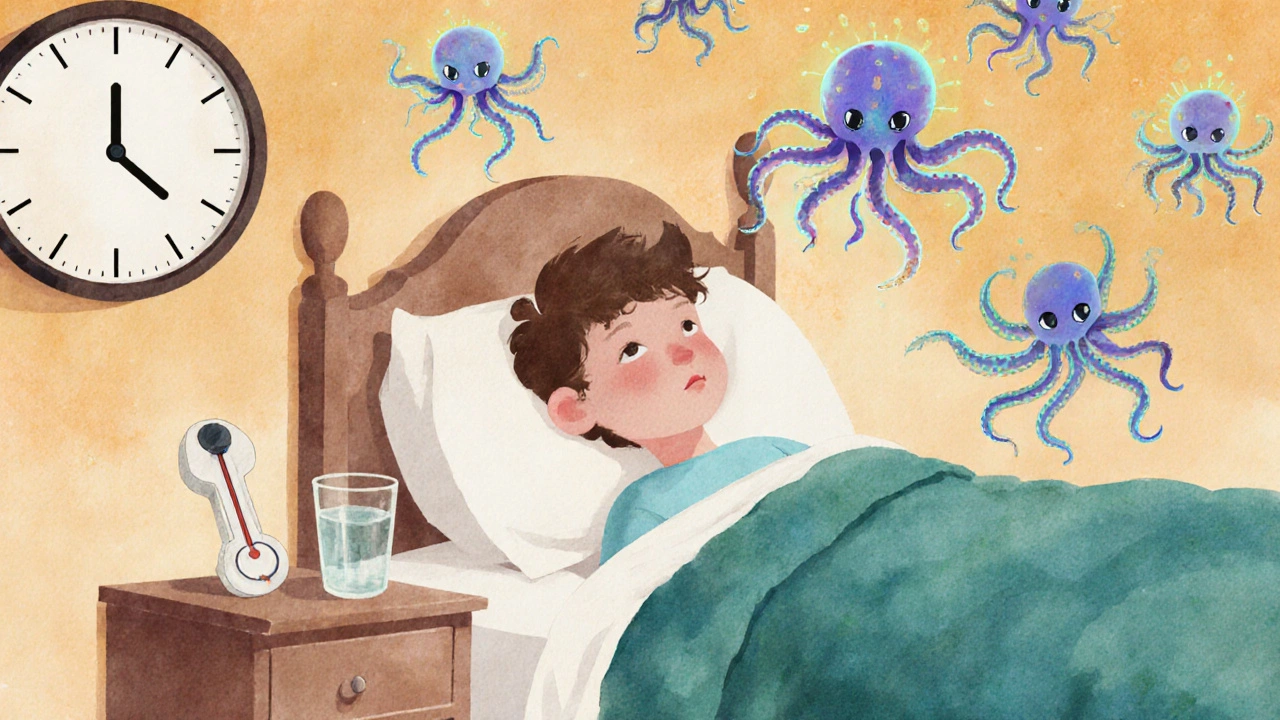Most people think of mononucleosis as just a bad sore throat that won’t go away. But if you’ve had it, you know it’s more than that. It’s the kind of exhaustion that makes getting out of bed feel like climbing a mountain. It’s the confusion when your doctor says "it’s just a virus"-but you’re still wiped out three months later. Mononucleosis, often called mono, isn’t a simple cold. It’s your body’s reaction to the Epstein-Barr virus (EBV), one of the most common human viruses on the planet. And while most people recover, the road back isn’t straight or fast.
What Exactly Is the Epstein-Barr Virus?
The Epstein-Barr virus isn’t some rare pathogen. It’s everywhere. About 95% of adults in the U.S. have been infected by age 35, according to the Cleveland Clinic. Most never even know it. In kids, EBV often causes no symptoms at all. But in teens and young adults, it can trigger infectious mononucleosis-a full-blown illness with fever, swollen glands, and that crushing fatigue.
EBV is a herpesvirus, which means once it gets in your body, it never fully leaves. It hides in your B-cells, the same immune cells that make antibodies. It goes dormant, then occasionally wakes up-usually without causing problems. But when it first hits a teenager’s immune system, things go haywire. The virus attacks the throat and lymph nodes, and your body responds with a flood of white blood cells. That’s what causes the swollen glands, sore throat, and fever.
It spreads through saliva. That’s why it’s called the "kissing disease." But you don’t need to kiss someone to catch it. Sharing a drink, a fork, or even a toothbrush can do it. The scary part? You can spread it for weeks before you even feel sick. And even after you start feeling better, you might still be shedding the virus in your saliva for months.
The Classic Symptoms: More Than Just a Sore Throat
Mononucleosis doesn’t show up like a regular cold. It has a signature trio: fever, sore throat, and swollen lymph nodes-especially in the neck. But here’s what most people don’t tell you: fatigue isn’t just a symptom. It’s the main event.
Studies show 98% of people with mono report extreme fatigue. Not "I’m tired after work" fatigue. This is the kind where you nap after brushing your teeth. Where walking to the kitchen leaves you breathless. One Reddit user, u/MonoWarrior89, wrote: "I thought I was recovering at week 3, then hit a wall at week 5 where just showering exhausted me. It took 11 weeks to return to part-time work."
Other symptoms include:
- Fever between 101°F and 104°F (38.3-40°C)
- White patches on tonsils (seen in about 60% of cases)
- Swollen spleen (in about half of patients)
- Headache and muscle aches
- Jaundice (yellowing of skin or eyes) in about 10% of cases
And here’s a trap: if you’re given ampicillin or amoxicillin-common antibiotics for sore throats-you’re likely to develop a full-body rash. Up to 90% of mono patients get this reaction. That’s why doctors now avoid antibiotics unless there’s clear evidence of a bacterial infection.
Why Recovery Takes So Long
Most viral infections-flu, COVID, even a bad cold-clear up in 1 to 2 weeks. Mono doesn’t. Symptoms can last 2 to 6 weeks. Fatigue? That can drag on for 2 to 4 months.
Why? Because EBV doesn’t just make you sick-it hijacks your immune system. Your body doesn’t just fight the virus; it fights itself. The inflammation and immune activation take time to wind down. Even after the fever and sore throat are gone, your body is still recovering from the toll.
Research from Stanford’s Fatigue Management Clinic shows that the best way to recover is through pacing: not pushing too hard, not resting too much. The "Pacing, Prioritizing, Planning" method works for many. Start at 50% of your pre-illness energy level. Do 20 minutes of activity, then 20 minutes of rest. Drink water. Repeat. Increase by only 10% per week-if you feel okay.
Trying to push through? That’s how people relapse. A 2023 survey of 1,200 patients on HealthUnlocked found that 63% took 4 to 8 weeks to return to normal school or work performance. Many were told to "just rest"-but rest alone doesn’t fix it. You need structure.

When Mono Gets Dangerous
Most people recover without issues. But there are risks you can’t ignore.
The biggest one: splenic rupture. About half of people with mono develop an enlarged spleen. It’s usually harmless-but if you play contact sports, get hit in the abdomen, or lift heavy weights, you could rupture it. That’s a medical emergency. The American College of Sports Medicine says: no contact sports for at least 4 weeks after diagnosis. Better yet, get an ultrasound to confirm your spleen has returned to normal before you go back.
Other rare but serious complications include:
- Airway blockage from swollen tonsils (5% of cases)
- Neurological issues like Guillain-Barré syndrome (less than 0.1% of cases)
- Liver inflammation leading to jaundice
And then there’s the long-term link to multiple sclerosis. A 2022 Harvard study of 10 million military personnel found people who had mono were 1.3 times more likely to develop MS later in life. That sounds scary-but remember, the absolute risk is still tiny: about 0.03%. EBV is common. MS is not. The connection is real, but the chance of developing MS after mono is still very low.
How It’s Diagnosed (and Why You Might Be Misdiagnosed)
Doctors often mistake mono for strep throat because both cause sore throats and fever. But here’s the difference: strep throat responds to antibiotics. Mono doesn’t. And if you take antibiotics for mono, you’ll likely get a rash.
The standard test is the Monospot, which checks for heterophile antibodies. It’s about 85% accurate after the second week of illness. But in the first week, it can be negative in up to 25% of cases. So if your test is negative but symptoms persist, your doctor should order EBV-specific blood tests: VCA-IgM (acute infection), VCA-IgG (past infection), and EBNA (shows you’ve had it for months).
A 2022 MedHelp survey found that 42% of people with mono were first told they had strep-and given antibiotics. That’s not just a misdiagnosis. It’s a risk factor for a rash, unnecessary side effects, and antibiotic resistance.

What Actually Helps (and What Doesn’t)
There’s no cure for mono. No antiviral drug makes it go away faster. The Infectious Diseases Society of America reviewed 12 studies and found no benefit from drugs like acyclovir. Some European studies show it reduces virus shedding, but not symptoms.
So what helps?
- Rest-but not too much. Lie around all day? You’ll feel worse. Move gently. Walk around the house. Stretch.
- Hydrate. Drink water. Coconut water. Broth. Avoid alcohol and caffeine.
- Manage pain and fever. Use acetaminophen (Tylenol). Avoid NSAIDs like ibuprofen if your platelets are low (a common side effect).
- Throat relief. Saltwater gargles, lozenges, and cold drinks help.
- Gradual return to activity. Start at 50% capacity. Increase by 10% weekly if no fatigue spikes.
Some people swear by low-dose naltrexone (LDN) for lingering fatigue. A 2023 University of Toronto study found it reduced fatigue by 40% compared to placebo in people still struggling after 6 months. It’s not FDA-approved for this use, but it’s being studied.
What’s New in Mono Research
Science is making progress. In January 2023, the NIH launched a trial testing valacyclovir plus steroids for severe throat swelling. Early results show symptom relief 35% faster.
The biggest breakthrough? The link between EBV and multiple sclerosis. In September 2023, the MS Society reported that a new antibody drug (atrasentan) targeting EBV-infected cells reduced new MS lesions by 60% in early trials. That could change how we treat MS-and maybe prevent it.
Moderna is also testing an mRNA vaccine for EBV. Early data shows 92% of participants developed protective antibodies. If it works, it could prevent mono and maybe even reduce future MS cases.
And Mount Sinai researchers found that high levels of IL-10 in the blood predict an 80% chance of fatigue lasting beyond 8 weeks. That means one day, doctors might be able to tell you how long your recovery will take-before it even starts.
Final Thoughts: Patience Is the Real Treatment
Mononucleosis isn’t a quick fix. It’s a long haul. You’ll feel better in weeks. But you’ll recover in months. And that’s okay. Pushing too hard doesn’t speed things up-it delays them.
Listen to your body. Track your energy. Don’t compare yourself to how you were before. This isn’t laziness. It’s biology.
And if your doctor tells you "it should be over by now," remember: science says otherwise. Fatigue after mono is real, documented, and common. You’re not imagining it. You’re not weak. You’re healing.
How long does mononucleosis fatigue last?
Fatigue from mononucleosis typically lasts 2 to 6 weeks, but in many cases, it can continue for 2 to 4 months. Studies show that 63% of patients take 4 to 8 weeks to return to normal work or school performance. A small percentage may experience fatigue beyond 6 months, especially if they return to activity too quickly. The key is pacing-gradually increasing activity while avoiding overexertion.
Can you get mono twice?
You won’t get symptomatic mononucleosis twice. Once you’ve been infected with Epstein-Barr virus, your body develops lifelong immunity to the disease. However, the virus stays dormant in your body and can reactivate periodically. These reactivations usually don’t cause symptoms, but you can still spread the virus to others through saliva during these times.
Is mononucleosis contagious after symptoms go away?
Yes. Even after your fever and sore throat disappear, you can still spread the Epstein-Barr virus through saliva for months. Some people shed the virus for up to 18 months after infection. That’s why it’s important to avoid sharing drinks, utensils, or toothbrushes-even if you feel fine.
Should I avoid exercise with mono?
Yes, especially contact sports and heavy lifting. About 50% of people with mono develop an enlarged spleen, which is vulnerable to rupture. The American College of Sports Medicine recommends avoiding all contact sports for at least 4 weeks after diagnosis, and only returning after an ultrasound confirms the spleen has returned to normal size. Light walking or stretching is usually fine, but listen to your body-if it makes you tired, stop.
Can antibiotics treat mononucleosis?
No. Mononucleosis is caused by a virus, not bacteria, so antibiotics won’t help. In fact, taking ampicillin or amoxicillin can cause a severe rash in up to 90% of mono patients. Antibiotics should only be used if there’s a confirmed secondary bacterial infection, like strep throat or sinusitis.
Is there a vaccine for mononucleosis?
Not yet, but one is in development. Moderna’s mRNA-1189 vaccine targeting Epstein-Barr virus entered Phase I trials in April 2023. Early results showed 92% of participants developed protective antibodies. If successful, this could prevent mono and potentially reduce the risk of long-term complications like multiple sclerosis.
Can mono cause chronic fatigue syndrome?
Mono doesn’t directly cause chronic fatigue syndrome (CFS), but it can trigger it in some people. Studies show that 10-15% of people who get mono go on to develop prolonged fatigue lasting more than 6 months. While this isn’t the same as CFS, it shares similar symptoms. Research is ongoing into biomarkers like elevated IL-10 levels, which may help predict who’s at risk.


Comments
Peter Aultman
Been there done that. Took me 5 months to feel normal again. Doctors kept saying "just rest" but rest alone didn't cut it. Pacing was the real game changer. Started with 10 minute walks and built up slow. No more crashing after brushing my teeth. Your body isn't lazy it's rebuilding.
November 10, 2025 at 21:48
Scarlett Walker
This is so true. I thought I was fine at week 6 then tried to go back to work and collapsed. Took me another month to recover. Don't let anyone tell you you're being dramatic. This virus messes with your whole system.
November 11, 2025 at 07:54
Brian Bell
Same. Took me 14 weeks to get back to running. Still can't do HIIT without crashing. But I'm alive and that's what matters. 🙌
November 11, 2025 at 21:00
Jane Johnson
Actually, the fatigue is psychological. People who believe they're chronically ill become chronically ill. It's not the virus, it's the narrative.
November 12, 2025 at 19:10
Sean Hwang
Yeah but the science says otherwise. IL-10 levels, immune dysregulation, prolonged inflammation. It's biology not mindset. I've seen too many people get told to "just snap out of it" and it makes things worse.
November 14, 2025 at 04:00
Ashley Durance
Exactly. And that's why the medical community is so behind. They still treat this like it's a bad cold. Meanwhile people are losing jobs, relationships, their sense of self. This isn't just fatigue. It's identity erosion.
November 14, 2025 at 22:21
Eleanora Keene
Don't let the naysayers get to you. You're not weak. You're healing. I started with 5 minutes of stretching and slowly built up. Now I'm back to yoga twice a week. Progress isn't linear. Celebrate the small wins.
November 15, 2025 at 22:51
Joe Goodrow
Why are we letting some virus run our lives? Back in my day we just pushed through. No one had time for this "fatigue" nonsense. Get back to work.
November 17, 2025 at 13:07
Sean Evans
LOL. You're part of the problem. Pushing through doesn't make you tough. It makes you a walking medical liability. I ruptured my spleen because some idiot told me to "just play through it". Now I have a scar and a lifetime of caution. 🤬
November 18, 2025 at 06:57
Brittany C
The EBV-Multiple Sclerosis link is fascinating. The 2022 Harvard cohort study showed a 1.3x increased risk, but the absolute risk remains under 0.05%. Still, the mechanistic plausibility via molecular mimicry warrants further investigation. The Moderna mRNA vaccine could be transformative if Phase III confirms immunogenicity.
November 18, 2025 at 08:39
Ryan Anderson
Just got diagnosed 3 weeks ago. Still in bed most days. But reading this made me feel less alone. Thanks for the science-backed info. No one else gets it. 😊
November 18, 2025 at 12:01
gent wood
There's a quiet dignity in this recovery. Not the loud, heroic kind. The kind where you learn to listen to your body's whispers instead of shouting at it. It's not about getting back to who you were. It's about becoming someone who knows their limits and respects them.
November 19, 2025 at 20:55
kshitij pandey
As someone from India, I've seen this in my family too. My cousin took 7 months. But here we have more rest culture. No pressure to rush. Maybe that's why recovery is more natural. Don't fight your body. Let it heal.
November 20, 2025 at 00:34
Anjan Patel
WHY IS NO ONE TALKING ABOUT THE FACT THAT THIS VIRUS IS A BIOLOGICAL WEAPON DESIGNED BY BIG PHARMA TO KEEP PEOPLE SICK AND BUYING MEDS?! THE EPSTEIN-BARR VIRUS IS A CONTROL MECHANISM! THEY KNOW ABOUT THE MS LINK AND THEY'RE HIDING IT! YOU'RE ALL BEING MANIPULATED!
November 20, 2025 at 08:11
Hrudananda Rath
One must observe with intellectual rigor that the prevailing discourse on mononucleosis exhibits a troubling conflation of pathophysiological reality with emotional projection. The notion of "pacing" as a therapeutic modality lacks rigorous, double-blind, placebo-controlled validation. One is reminded of the Victorian era's reliance on rest cures for hysteria.
November 21, 2025 at 16:20
Don Ablett
Interesting data on IL-10 as a predictive biomarker. Have the researchers controlled for baseline inflammatory markers? The correlation may be confounded by pre-existing immune activation. Also, what was the sample size of the Mount Sinai cohort?
November 23, 2025 at 01:26
Chris Ashley
Ugh I got mono in college and now I can't even drink out of a cup without someone asking if I'm contagious. Like I'm some walking plague. Can we just stop calling it the kissing disease? It's gross and inaccurate.
November 24, 2025 at 01:19
Nathan Hsu
And yet... the Epstein-Barr virus has co-evolved with humans for millennia. It is not an invader, but a tenant. We host it. It hosts us. To fight it is to fight our own biology. Perhaps the answer is not eradication, but harmony.
November 24, 2025 at 16:25
Scott Saleska
Actually, you're all missing the point. The real issue is that people are too lazy to recover properly. If you just did 30 minutes of cardio every day, you'd be fine. This whole "pacing" thing is just an excuse for inactivity. I've seen it a hundred times.
November 26, 2025 at 03:03
Write a comment